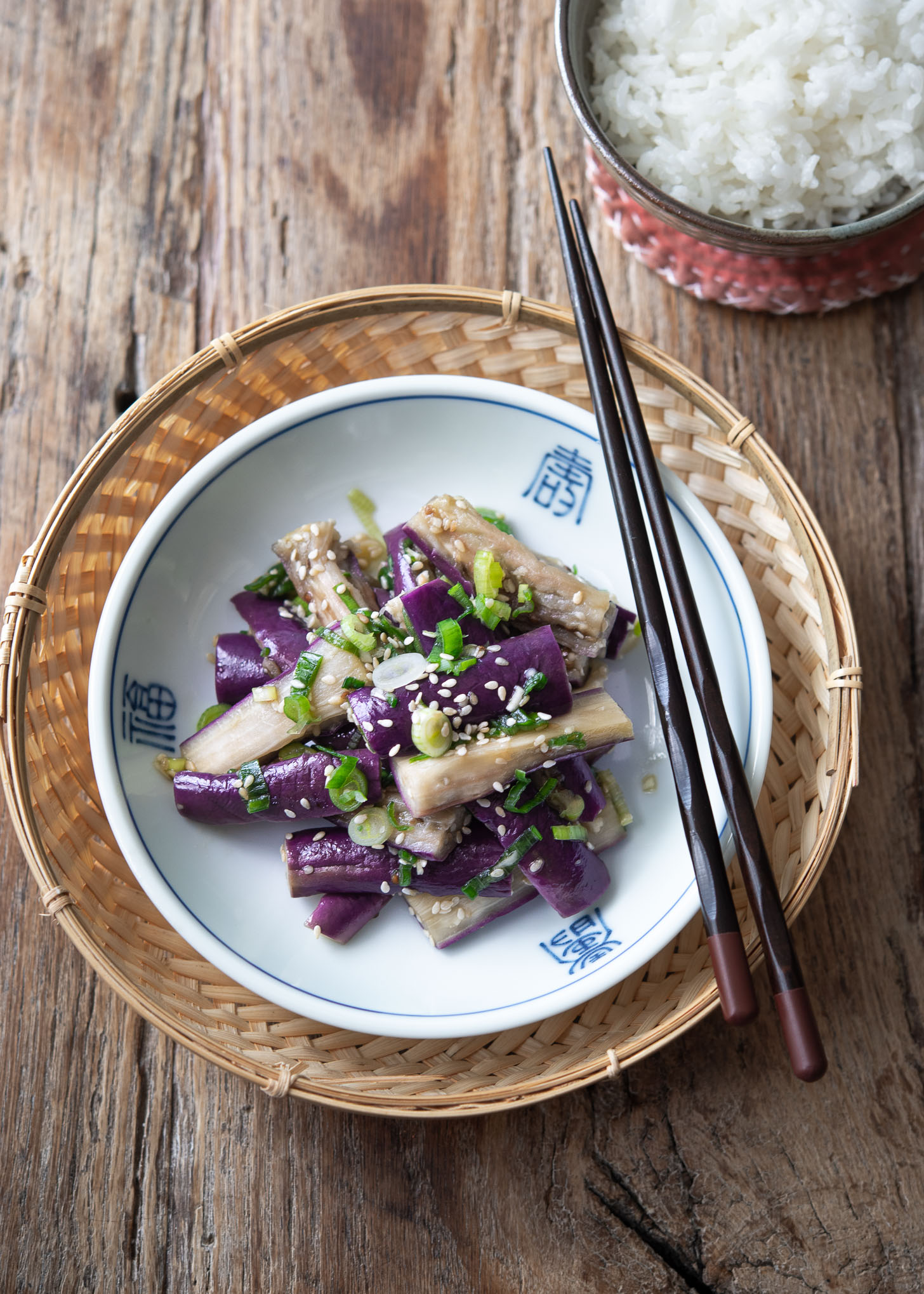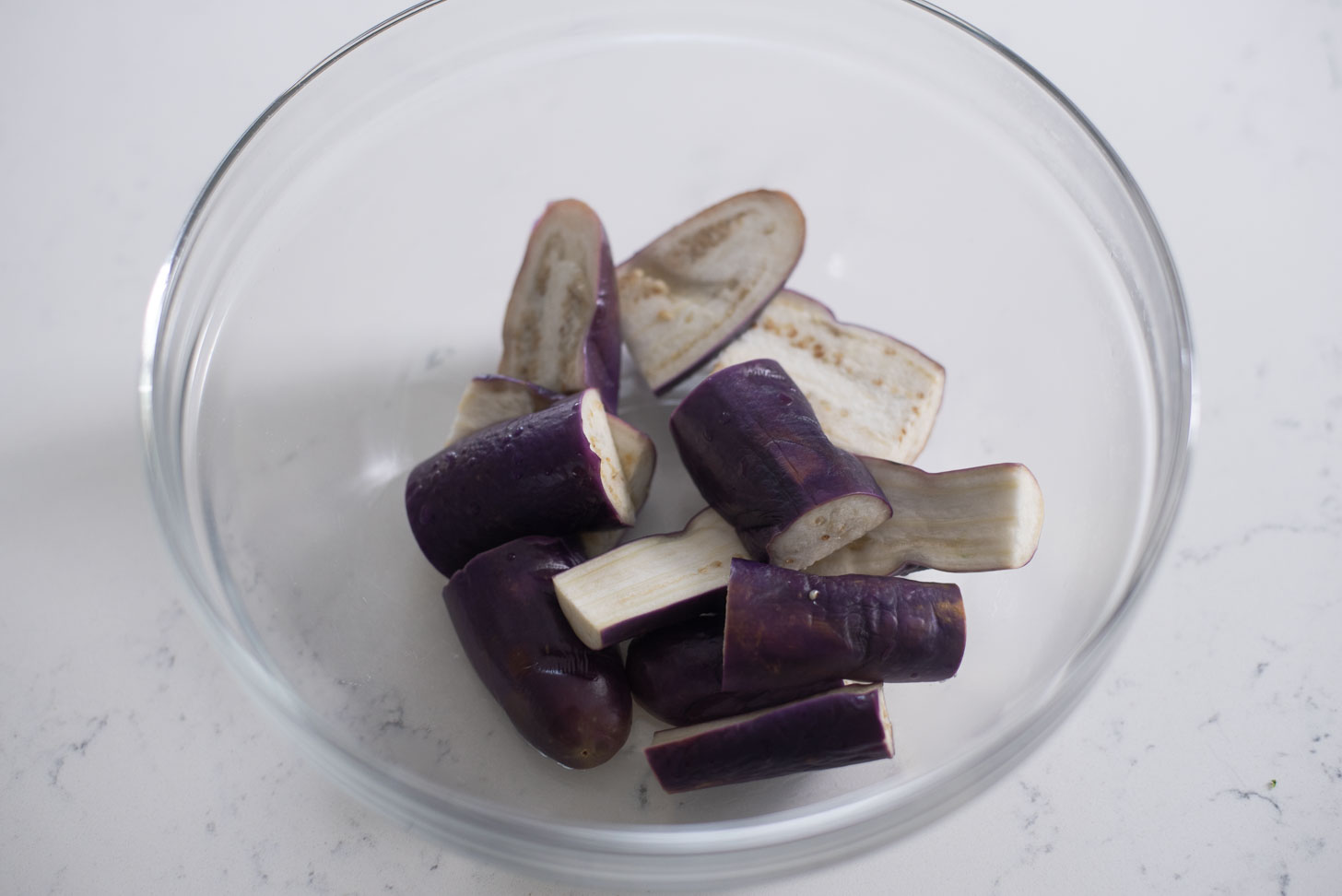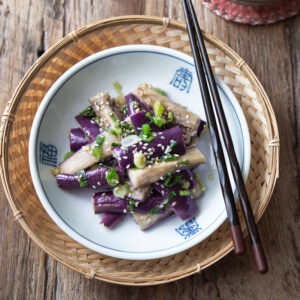Steamed Korean Eggplant (Gaji Namul)
The Korean eggplant side dish called gaji namul is a simple and healthy side dish made with steamed eggplant. Enjoy the vibrant purple color of eggplant along with its soft texture and delicious taste. It’s very easy to make.

Eggplant is definitely a love or hate vegetable. For me, it’s love. I love the beautiful shade of purple, and the soft texture makes it enjoyable to eat with rice.
I think most people who don’t like eggplant take issue with the texture — the mushiness!
But the mushiness comes from overcooking. When eggplants are cooked properly, they become one of the most enjoyable and versatile vegetables — one that you can adapt to many dishes.
What is gaji namul?
Gaji means eggplant, and namul refers to any side salad dish made with a single vegetable. This gaji namul is one of staple Korean side dishes, popular in the summertime when fresh eggplants are abundant.
Another hit summer side dish? Check out my Korean cucumber salad! It’s super quick and delicious to pair with any Asian recipes.
Korean cuisine uses a steaming method to cook eggplant for this particular recipe. Properly steamed eggplant is torn into bite-sized pieces and then tossed with Korean soup soy sauce seasoning. A simple Korean eggplant salad is made in no time.
By steaming eggplants, you will get to enjoy one of the easiest and healthiest Korean banchan in no time. Gaji namul is also great for Bibimbap topping ingredients.

What eggplants to use
There are a variety of eggplants around the world. The best type for making this Korean eggplant side dish is naturally Korean or Asian (Japanese) eggplants. They are skinnier and have a better texture for this dish than the larger eggplants known as Italian eggplants.

Look for firm and slender eggplants with a deep purple color and shiny skin. Korean eggplants have tender skin, so you won’t need to peel them. You can find them easily in Korean/Asian markets. Some farmer’s markets carry them as well. So be on the look out for them!
How to steam eggplant
Do you want to maintain the vibrant color on the skin?
Here’s how you do it.
- Soak the eggplant pieces in a bowl of water mixed with a little bit of vinegar for 5 minutes. Drain the eggplants and put them in a hot steamer.
- Steam for 3-4 minutes until your desired softness is reached. 3 minutes of steam time will yield a soft bite with a firmer texture in the center.
- The longer you steam, the softer it gets. If you steam it longer than 4 minutes, it can quickly become mushy. Some people actually prefer their eggplant mushy though, so the choice is up to you.
How to make Korean eggplant side dish

Add vinegar to a bowl of water. Cut eggplant half in lengthwise. Slice each half into 3-4 segments. Put the eggplant pieces in the vinegar water for 5 minutes.

Meanwhile, put a steamer basket over a pot of water and bring to a boil on high heat. Drain the eggplants and put in the steamer, cover, and steam for 3-4 minutes or until the eggplants are softened.


Transfer the softened eggplants in a bowl and let them cool little bit. Tear or slice each section of eggplant into bite-size thin strips.

Add garlic, green onion, Korean soup soy sauce, sesame oil, and sesame seeds. Toss well to coat the eggplants.
Note: Serve this Korean side dish at room temperature or chill in the refrigerator until ready to serve. You can store it for up to 1 week in the fridge.

What to serve with Korean eggplant side dish
Gaji namul can go with pretty much any Korean main dishes. You can serve it alongside all sorts of foods such as bulgogi, Korean spicy pork, and chicken bulgogi.
Korean soups and stews are no exception either! This gaji namul makes great accompaniment to doenajng jjigae, kimchi jjigae or soondubu jjigae.
This versatile Korean eggplant side dish can even make a great namul (vegetable) component for bibimbap recipe . If you want something vegetarian, you can make this side dish the star of the show by making eggplant bibimbap with a simple gochujang sauce.
Other Korean side dishes
If you enjoy bunch of Korean side dishes (banchan), try some of these recipes. They are all quick and easy to make, and very delicious.
- Korean Braised Lotus Root
- Korean Spinach Side Dish (Sigeumchi Namul)
- Gamja Jorim
- Korean Steamed Egg (Gyeran-jjim)
- Korean Pan-Fried Tofu (Dubu Buchim)

Steamed Korean Eggplant (Gaji Namul)
Ingredients
- 2 Asian eggplant or Japanese eggplant
- 4 cup water
- 2 tbsp white vinegar
- 1 clove garlic, finely minced
- 1 green onion, finely chopped
- 2 tsp Korean soup soy sauce (gukganjang)
- 2 tsp sesame oil
- 1 tbsp toasted sesame seeds
Instructions
- Add vinegar to a bowl of water. Cut eggplant half in lengthwise. Slice each half into 3-4 segments. Put the eggplant pieces in the vinegar water for 5 minutes.
- Meanwhile, put a steamer basket over a pot of water and bring to a boil on high heat. Drain the eggplants and put in the steamer, cover, and steam for 3-4 minutes or until the eggplants are softened.
- Transfer the softened eggplants in a bowl and let them cool little bit. Tear or slice each section of eggplant into bite-size thin strips.
- Add garlic, green onion, Korean soup soy sauce, sesame oil, and sesame seeds. Toss well to coat the eggplants. Serve with rice.
- Note: Serve this Korean side dish at room temperature or chill in the refrigerator until ready to serve. You can store it for up to 1 week in the fridge.


I only used to fry the eggplants but to steam them is much easier. The recipe turned out really well and is very simple. I will definitely use it again!
Awesome! So happy to hear that. Thanks for the comment!